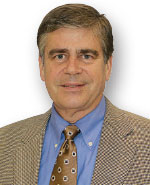Seeds are money

Karl Danneberger
Seeds are a turfgrass management topic often taken for granted. We spend considerable time and effort researching the best cultivars or varieties to use on golf courses, but we focus little attention on the seed itself. Given their small size and the tremendous number of seeds we use, each one by itself can seem insignificant, especially compared with their agronomic cousins.
Soybean and corn seeds are planted in rows, with each seed placed or drilled into the row. If a seed row fails to emerge or uneven plant emergence occurs, the farmer then focuses on why the seed is not performing. Reasons for unsatisfactory germination include field conditions, weather and planter failure, or it could be something to do with the seed itself. Given that every plant that comes from a seed represents money, diagnosing the problem is important.
In the turf world, we broadcast seed in such numbers that looking at individual seed performance is not possible. We judge the success of an establishing turf stand based on an overall area. If for some reason the newly seeded turf fails, it’s judged on the overall area view. Potential reasons for stand failure include environment, management and soil conditions, but again, the seed itself often goes unexamined. It never fails to amaze me.
When golf course superintendents rebuild putting greens, they have the root-zone mix tested to meet specifications and often retest the material as it’s delivered on site. After completing quality control on the mix, the green is shaped to the proper depth, smoothed to just the right contours, then seeded.
Superintendents know (or think they know) the seed they’re planting because it’s identified on a tag or label. You would think that tag was gospel. However, during seeding, keep some of the seed you use, along with the tags. If you’ve ruled out all other factors in a failure, you then have a source of seed you can test as a potential failure cause.
As seeds germinate and seedlings emerge, a fundamental question arises. When is a seedling no longer a seedling?
A wide range of explanations exist to answer this question, ranging from a given number of days or weeks, to emergence of X number of leaves, to the nodal stage. None of these answers seem to get to the heart of it.
Turf seed is comprised mainly of the embryo and the endosperm. The embryo is where root-like structures emerge — usually first — followed quickly by the shoot. During this initial development, the endosperm provides all energy for roots and shoots to develop.
Seed has a small size and relatively small endosperm. This is why we don’t plant turf seeds as deep as larger agronomic crop seed. Once the leaves emerge and photosynthesis begins, the plant becomes autotrophic (independent). It’s at this point that I no longer consider the seedling a true seedling. By photosynthesizing, the seedling is no longer dependent upon the endosperm for energy.
Germination and emergence of these seedlings occurs quickly. I’ve heard superintendents speak of creeping bentgrass germination and emergence in as little as three to five days. This comment often is followed by a complaint that the plants seem to be just “sitting there.” As these seedlings transition to autotrophic plants, the energy they capture from photosynthesis goes into root and stem development, a much slower process than, for example, an annual grassy weed, which is putting almost all of its newly acquired energy into reproduction.
Never take seeds in a turf seed bag for granted. Seeds are the beginnings of a plant’s life. The genetics, the internal processes that govern germination, the initial growth and how these early stages dictate plant competition — it’s all fascinating. Those processes govern how we manage that turf for years to come.










